How to Qualify as a Heritage Turkey?
While heritage turkeys are an old variety of breeds, their age is not the only factor that makes them “heritage.” They have distinct characteristics that other turkey breeds don’t have.
To help you distinguish a heritage turkey from a non-heritage one, below are some characteristics that a turkey breed should possess to qualify as a heritage turkey:
- The turkey breed should mate naturally, which means that reproduction should be done without human assistance.
- The turkey breed should have a slow growth rate. Ideally, a heritage turkey reaches maturity at least 28 weeks of age.
- The turkey breed should also have a longer lifespan in terms of productivity. Toms (male turkeys) should be productive between 3 and 5 years old, while hens should be between 5 and 7 years old.
What is Special About a Heritage Turkey?
A heritage turkey is so special in so many ways. Since they are raised antibiotic-free or without additives, their meat is very healthy and has a superior taste.
Although they are quite difficult to produce, these old-fashioned breeds can be sold at a higher price than commercial ones. Therefore, raising heritage turkeys can be a profitable business.
What Are the Best Breeds of Heritage Turkeys?
So far, eight heritage turkey breeds are admitted to the American Poultry Association (APA) in its Standard of Perfection before the 20th century. Nevertheless, there have been some additions that the APA has not yet recognized, but the Livestock Conservancy does. Below are the ten heritage turkey breeds that you can try breeding.
1. Beltsville Small White Turkey
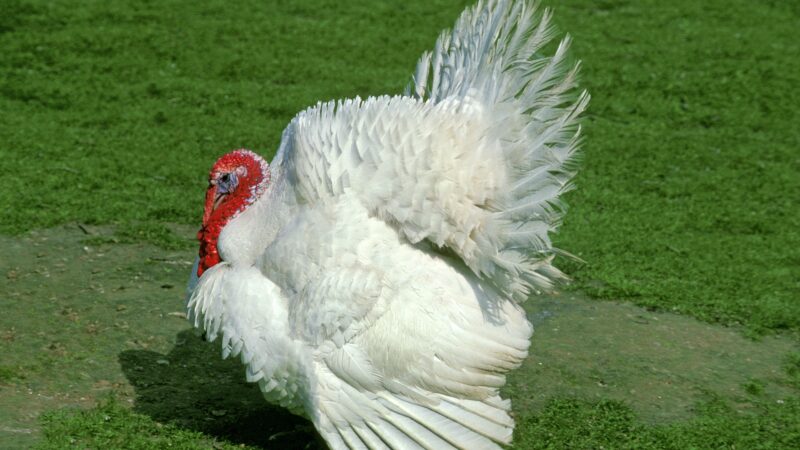
History
As the name suggests, the Beltsville Small White turkey breed originated in Beltsville, Maryland. It was created via a breeding program started by the Beltsville Agricultural Research Center (BARC), which lasted from 1934 to 1941. At that time, the purpose was to create a smaller heritage turkey breed that consumers have been demanding.
To develop the Beltsville Small White, researchers used several heritage turkey breeds. This includes the Bronze, Narragansett, White Austrian, White Holland, and Wild turkey breeds. This heritage breed was accepted to the APA in 1951 but was almost extinct in the 1970s. As of posting, the Livestock Conservancy lists this turkey breed as “Critical.”
Appearance
Beltsville Small White turkeys are generally small, although a few of them can be medium-sized. They have a compact, broad-breasted body, a small head, a small snood, small tails, and short legs.
These turkeys have white plumage, a red to bluish-white head, dark brown eyes, horn-colored beaks, a black beard, and pinkish-white toes and shanks.
Height
There are no records stating the height of Beltsville Small White turkeys. But because they are relatively small, these domesticated turkeys are not as tall as the others.
Weight
At mature market age, male Beltsville Small White turkeys have an average weight of 17 lbs (7.7 kilos), while females weigh about 10 lbs. (4.5 kilos).
Characteristics
Beltsville Small White turkeys are generally calm and docile, yet outgoing. But then, some of them can be aggressive for no reason at all, while others have no interest in humans unless it is feeding time.
But overall, these thick-bodied birds are very easy to manage. They are also more tolerant to heat than in cold weather.
Lifespan
When properly taken care of, Beltsville Small White turkeys can live up to 9 years.
Purpose
As mentioned earlier, the Beltsville Small White turkey was originally bred for meat production. Yet, this heritage turkey breed is also a decent egg layer.
Hens can lay 150 to 180 eggs per year. Their eggs are big and are usually pale buff with reddish-brown marks. Nonetheless, turkeys are not usually bred mainly for egg production.
2. Black Turkey
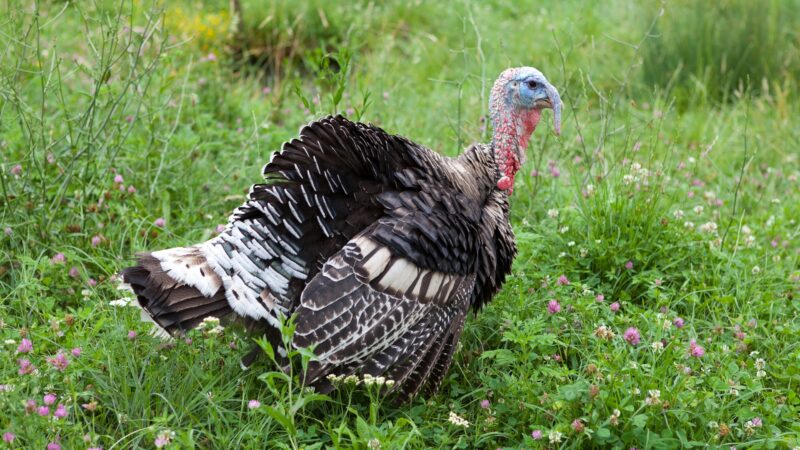
History
Also known as the Norfolk Black turkey or Black Spanish turkey, the Black turkey originated in Europe and was brought to America by Spanish explorers in the 1500s.
The original heritage breed was crossed with Eastern wild turkeys, and the offspring became the basis for the Black turkey variety in America. It was also known in France and Italy.
The Black heritage turkey was recognized by the APA in 1874. Their population was huge on the East Coast, including Maryland and Virginia until the 20th century.
Yet, it was not as popular as other heritage varieties such as Bronze, White Holland, and Narragansett. The Livestock Conservancy currently lists the Black turkey as “Endangered.”
Appearance
Black turkeys are famous for having dense metallic black plumage with a greenish sheen. They have a red head, dark brown eyes, a black beak, and a bluish-white neck.
The Shanks and toes of the young ones are black but will turn pink as they mature. Like most turkey breeds, their skin is also white. Yet, some of them can have a yellow tinge.
Height
There are no records stating the height of Black turkeys. Nonetheless, they are seen as reasonably tall.
Weight
Male Black turkeys have an average weight of 23 lbs (10.4 kilos), while females are around 14 lbs (6.3 kilos).
Characteristics
Norfolk Black turkeys are generally docile and have a calm disposition. Nonetheless, they are curious and alert. These attractive birds are very personable and cold-hardy. Yet, they can be loud and aggressive at times and may get into trouble. But overall, this black variety is extremely manageable and is a very healthy turkey breed.
Lifespan
If well taken care of, Black Spanish turkeys can live up to 10 years.
Purpose
The Black Spanish turkey was originally bred for meat production and until now. Their meat is of premium quality and very delicious. Hens lay 40-50 cream to brown eggs a year or only an egg a week. They can also be kept as pets, as long as you don’t have small children.
3. Blue Slate Turkey
History
The Blue State turkey originated in America, but the exact place of origin and how it was created remain unknown. According to a theory, this heritage turkey breed is a result of crossing a Black turkey and a White turkey, but it was not proven. It is believed that its slate gene is similar to that of Andalusian chickens. There are also no records, though.
The APA recognized the Blue State turkey in 1874. Although quite popular in poultry shows and has been gaining interest from various breeders, the Livestock Conservancy lists the State turkey as “Endangered.” There are also only a few documents about their productivity, which means that its current production potential seems uncertain.
Appearance
As the name implies, the Blue State turkey has blue plumage. This color variety comes in three color phases – blue with some black specks, pure black, and solid bluish gray.
Hens have lighter colors than toms. They have brown eyes, horn-colored beaks, black beards, and pink shanks. Their head, throat, and wattles are red or bluish-white.
Height
There are no records describing how tall Blue State turkeys are, except that they are medium-sized birds.
Weight
The Blue State turkey can weigh from 18 to 27 lbs (8.2 to 12.2 kilos), with females being significantly lighter than males.
Characteristics
Also called Lavender turkeys, Blue State turkeys are generally docile, easy to tame, and friendly to humans. In fact, they can make great pets.
This gorgeous but rare turkey breed is cold hardy and does not require grooming. The Blue State turkey does well in free range and is an excellent forager. Once fed properly, it tends to be a healthy breed.
Lifespan
With proper care and diet, the Blue State turkey can live between 5 and 9 years.
Purpose
The Blue State turkey has two main purposes – for meat production and as show birds. It has flavored, firm, and moist meat. But being terrible egg layers, hens lay only about 20-25 eggs a year. Consider yourself lucky if they lay one egg per week.
4. Bourbon Red Turkey
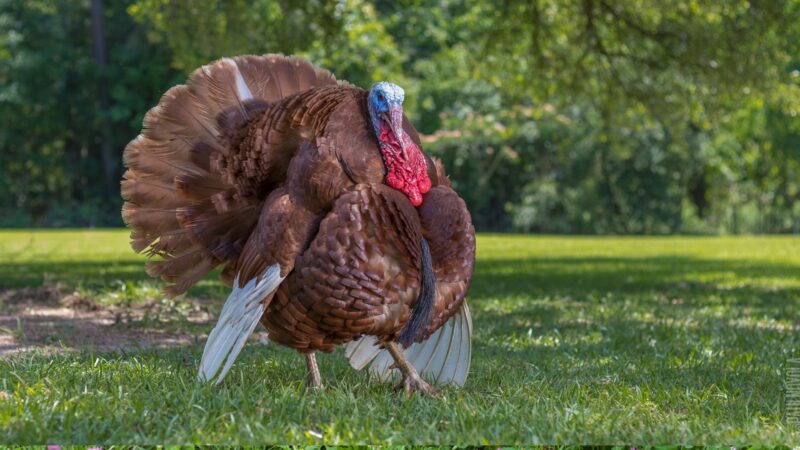
History
The Bourbon Red turkey originated in Bourbon County, Kentucky, hence the name. It was developed in the late 19th century by J. F. Barbee by crossing Bronze, Buff, and White Holland turkeys. At that time, he called the breed “Bourbon Butternuts.” But for some reason, the name was not catchy. So, he decided to change it to “Bourbon Red.”
The Bourbon Red variety was recognized by the APA in 1909 and became a very important commercial variety from the 1930s to 1940s. But because of the increasing demand for broad-breasted varieties, this breed gradually lost its popularity. As of posting, the Livestock Conservancy lists the Bourbon Red in the “Watch” category.
Appearance
Bourbon Red turkeys are also named after their body feather color – dark red. Yet, toms have black edges on their bodies.
Both sexes have chestnut mahogany neck and breast feathers, while their wing and tail feathers are white. Their beaks are dark on the base and light horn-colored at the tip. They have red throats and wattles, which can change to bluish-white.
Height
So far, there are no records about the height of Bourbon Red turkeys.
Weight
Adult male Bourbon Red turkeys weigh about 32 lbs (14.5 kilos), while adult females weigh around 18 lbs (8.2 kilos). On the other hand, young males weigh about 23 lbs (10.4 kilos), and young females weigh around 14 lbs (6.3 kilos).
Characteristics
Bourbon Red turkeys are admired for being friendly and having a sweet demeanor. These eye-catching birds are docile and generally calm, although males can sometimes be aggressive.
Hens are very dedicated mothers and tend to go broody than other breeds. Nonetheless, both sexes tolerate confinement and are also excellent foragers.
Lifespan
When treated properly, Bourbon Red turkeys can live up to 10 years.
Purpose
Bourbon Red turkeys are bred mainly for meat production but are also useful in shows. Their carcasses are huge and clean, and their meat has a superb taste.
They are not excellent egg layers, and hens can lay only about 50-70 pale cream to medium brown eggs a year. As expected, this heritage turkey breed is also raised as backyard pets.
5. Jersey Buff Turkey
History
The Jersey Buff turkey originated in the mid-Atlantic region in the 1800s, a time when buff turkeys are very difficult to breed. Despite having been heavily promoted, their popularity at that time was short-lived.
This heritage turkey breed was recognized by the APA in 1874 but was removed in 1915. Since then, the Jersey Buff turkeys became extinct.
Fortunately, efforts to bring Jersey Buff turkeys back started in the 1940s. Since the original strain of the Jersey Buff turkey was used in creating Bourbon Red turkeys, breeders are now doing it the other way around. The New Jersey Agricultural Experiment Station (NJAES) developed the modern Jersey Buff turkey using Bourbon Red turkeys.
Appearance
Jersey Buff turkeys have reddish-buff-colored plumage, hence the name. They have white wing feathers with buff shading and white tail feathers with a light buff bar across them close to the end.
Both sexes have the same body feather color, hazel eyes, black beards, and bluish-white shanks and toes. The color of hens becomes lighter as they age.
Height
The average height of Jersey Buff turkeys is unknown but is expected to be not too high or too low.
Weight
Fully grown Jersey Buff toms are around 23 lbs (10.4 kilos), while adult hens are about 12 lbs (5.4 kilos).
Characteristics
Jersey Buff turkeys are generally calm and docile and are quite easy to tame, making them ideal for small-scale breeders. These old but beautiful birds are very strong and cold-hardy.
Interestingly, they are also great backyard pets. But just like other turkey breeds, individual temperament can vary, and it is always best to handle them with care.
Lifespan
There are no records about the lifespan of Jersey Buff turkeys. But generally, a healthy adult can live longer than commercial turkey breeds.
Purpose
The primary purpose of Jersey Buff turkeys is meat production. In fact, this breed is one of the tastiest turkey meats. But then, some breeders raise them as pets and for exhibitions due to their attractive feathers.
Although there are no official records on how many eggs their hens can lay in a year, they are considered good egg producers.
6. Midget White Turkey
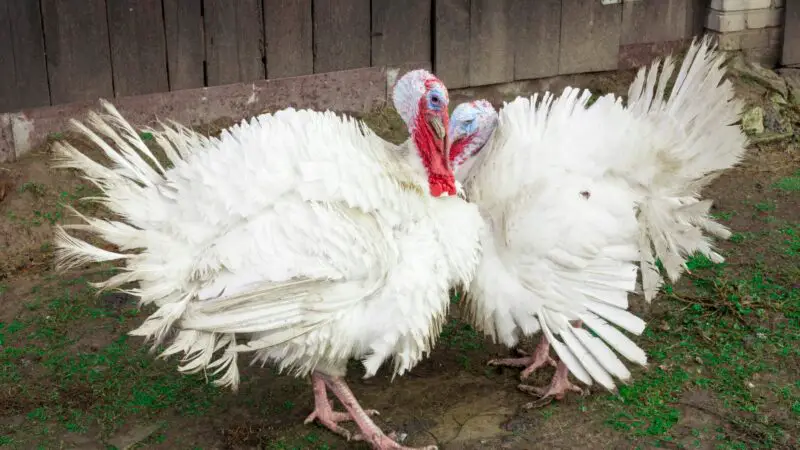
History
The Midget White turkey breed was created by Dr. J. Robert Smyth of the University of Massachusetts Amherst in the early 1950s. During that time, there was an expected demand for a small version of the broad-breasted turkey. To create the breed, he used an excellent line of Royal Palm turkeys and large broad-breasted white turkeys.
Sad to say, the anticipated market did not happen. The Midget White did not become popular, and the breed nearly became extinct.
Fortunately, Dr. Bernie Wentworth of the University of Wisconsin started to revive the Midget White in 1971. Although the numbers are now slowly rising, this heritage breed is not yet recognized by the APA.
Appearance
The Midget White turkey looks like the Beltsville Whites, except that they are smaller and their breasts are not that broad. In fact, this breed is the smallest among all the standard turkey varieties.
Although adults are pure white, the young ones are dull yellow with some small dark spots and they have darker heads and orange beaks.
Height
There are no records about the height of Midget White turkeys, but they are presumably shorter than most heritage breeds.
Weight
Because of their small size, Midget White turkeys are not a heavy breed. Toms weigh about 13 lbs (5.9 kilos), and hens only weigh around 8 lbs (3.62 kilos).
Characteristics
Midget White turkeys are surprisingly friendly, docile, and very easy to tame. Aside from being reliable watchdogs, they are also willing to play with small children.
They tend to be friendlier than Beltsville Whites. These small turkeys are always curious and love to follow their owners. They are also cold-hardy and don’t mind being in confinement.
Lifespan
When raised properly, Midget White turkeys have an average lifespan of 5 to 7 years.
Purpose
Midget White turkeys are raised mainly for meat production but can also be kept as pets. Their meat is very dark, but the flavor is very rich and delicious. Small children are also safe playing with them.
Interestingly, they are also considered good egg layers. On average, hens can lay 60-80 pale cream eggs a year, with a hatchability of 75-80%.
7. Narragansett Turkey
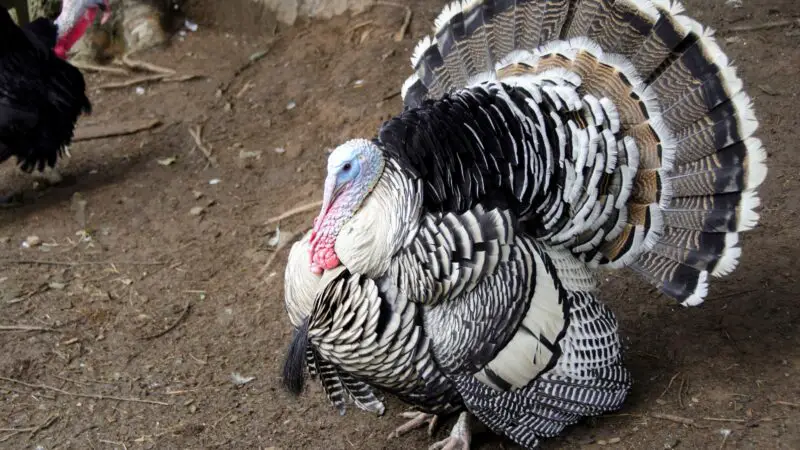
History
As the name implies, the Narragansett turkey originated in Narragansett Bay in Rhode Island. This heritage breed was brought to America by European colonists in the early 1600s.
Narragansett turkeys are most likely products of crossing Norfolk Blacks and wild native Eastern turkeys. There are no historical documents to prove this, though.
The Narragansett turkey was recognized by the APA in 1874. It was popular in New England, especially in Connecticut and Rhode Island.
But in the early 1900s, its popularity started to decline when the Standard Bronze turkey appeared and was standardized. The Livestock Conservancy now lists the Narragansett turkey under the “Watch” category.
Appearance
Narragansett turkeys somehow look like the Standard Bronze turkey but are unique with their fan-shaped tail. Their feathers have patterns of black, gray, tan, and white.
They have a red to bluish-white head, a grayish-black beak, a black beard, and red wattles. Their wings are black and white barring, while their feet and legs are orange-pink.
Height
Male Narragansett turkeys can grow up to 48 inches (1.2 m) tall, while females are a bit shorter.
Weight
Adult male Narragansett turkeys weigh around 28 lbs (12.7 kilos), while adult hens are about 18 lbs (8.2 kilos). Young males weigh around 23 lbs (10.4 kilos), while young females weigh about 14 lbs (6.4 kilos).
Characteristics
Narragansett turkeys are prized for being one of the calmest heritage turkeys. Hens are good mothers and tend to go broody longer than other heritage breeds.
They are fast runners, good flyers, and are likely to roost on trees, especially at night. This heritage breed is also a remarkably cold hardy bird and is extremely tolerant even in the winter.
Lifespan
Like most heritage turkey breeds, Narragansett turkeys can live up to 10 years.
Purpose
Narragansett turkeys are commonly bred for meat production. Their meat is known for being very tasty and of high quality.
Hens are seasonal egg layers and can lay 50-100 large eggs a year. And because of their calm disposition, they also make great pets, even if you have small children. Their unique beauty can also draw attention during exhibits.
8. Royal Palm Turkey
History
The Royal Palm turkey was developed in the 1920s by Enoch Carson of Lake Worth, Florida. But then, some reports say that this domestic turkey originated in the UK.
Although the development process has no official records, they were likely the product of crossbreeding the Black, Bronze, Narragansett, and some native turkey breeds.
However, it took several years before the consistency of the color of the Royal Palm turkey was stabilized. For this reason, this heritage breed was only recognized by the APA in 1971. It has similar patterns to the Black-laced White, Cröllwitzer, and Pied turkeys from the UK. The Royal Palm turkey is now listed under the “Watch” category.
Appearance
Royal Palm turkeys have a very distinct color pattern on their body feathers. Their breast and wing feathers are white with sharp, metallic black on the narrow edges.
Their shanks and feet are deep pink. They also have red or blue heads, red wattles, light brown eyes, black beards, white necks, black backs, as well as white tails with black rims.
Height
Royal Palm turkeys are relatively small and quite shorter than most heritage turkey breeds. There are no official records about their height, though.
Weight
Male adult Royal Palm turkeys are between 20 and 22 lbs (9.1 and 10 kilos), while adult females weigh only about 12 lbs (5.4 kilos). Young males weigh around 16 lbs (7.3 kilos), and young females are about 10 lbs (4.5 kilos).
Characteristics
Royal Palm turkeys are generally calm, friendly, and very sociable. They have an active personalities and enjoy close contact with humans.
When raised by hand, this small-sized turkey breed can easily recognize its owners and pet dogs. Although toms can be aggressive sometimes, they are considered less aggressive than other heritage breeds.
Lifespan
When treated properly, Royal Palm turkeys have an average lifespan of 10 years.
Purpose
Like other heritage turkey breeds, the Royal Palm is not bred for commercial meat production. In addition, their carcass is small and is not saleable. Yet, their meat is tasty and great for your dinner table.
But then, this uniquely beautiful heritage breed is ideal for shows and exhibitions. Their calm behavior also makes them great backyard pets.
Related: Royal Palm Turkey | Can Royal Palm Turkeys Fly?
9. Standard Bronze Turkey

History
The Standard Bronze turkey breed has a very interesting history. It originated in Europe but became the most popular turkey breed in the US in the 1700s. Interestingly, the “Bronze” name was not used until the early 1830s. Their wild turkey ancestors have a bronze-colored metallic sheen, which made the new breeders decide to add “Bronze.”
The Bronze variety was recognized by the APA in 1874. But at the start of the 20th century, a broader-breasted Bronze turkey was brought to the United States from England. This caused the Bronze turkey to gradually lose its popularity until the breed was categorized into two groups – the Broad Breasted Bronze and the Standard Bronze.
Appearance
Also sometimes called the Unimproved Bronze, the Standard Bronze turkey looks like their wild ancestors. Both of them have a greenish cast to their feathers.
But unlike their older breed, they have a whitish fringe on their tail feathers instead of brown. However, they are much smaller than the Broad Breasted Bronze, which is no longer in use.
Height
The Standard Bronze turkey can grow up to 4 feet (1.2 m) tall but is a bit shorter than the Broad Breasted Bronze.
Weight
Male adult Standard Bronze turkeys are between 35 and 38 lbs (15.8 and 17.2 kilos), while adult females weigh between 18 and 22 lbs (8.2 and 9.9 kilos). Young males weigh about 25 lbs (11.3 kilos), and young females are around 16 lbs (7.3 kilos).
Characteristics
Standard Bronze turkeys are curious but are docile and very personable. In fact, they love following their owner around the farm.
These heavy birds are also superb foragers and enjoy roaming around. But because of their huge size, they are not good flyers. Amazingly, Bronze turkeys are very hardy and can tolerate heat as well.
Lifespan
Standard Bronze turkeys are known for having a long lifespan and can live from 8 to 12 years.
Purpose
The original Bronze variety was not used for commercial production. But when the Standard Bronze arrived, the breed was improved in terms of health and survivability.
Breeders became interested in breeding them for meat production, and the meat had a superior flavor. Hens can lay 20-30 extra large eggs per year during their first two years.
10. White Holland Turkey
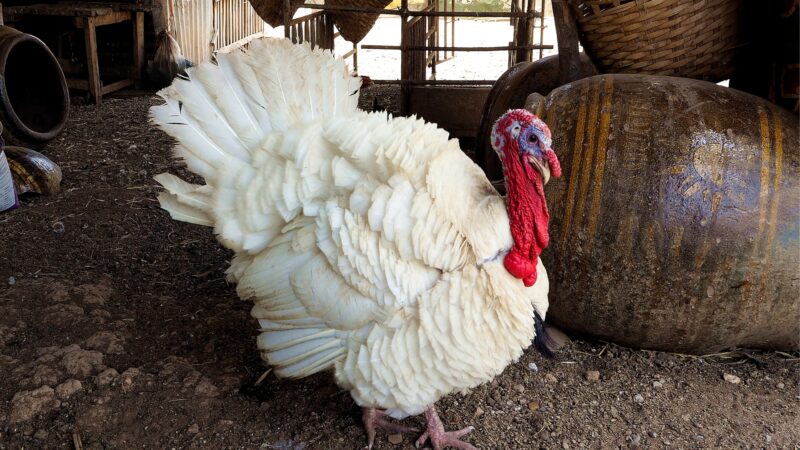
History
Contrary to popular myth, the White Holland turkey is not a Dutch breed. Instead, this heritage turkey originated in the US in the 1800s.
Nevertheless, white turkeys were popular in the Netherlands at that time. Hence, it’s also possible that Dutch settlers could have brought them to America and become the ancestors of White Holland.
But despite its intriguing history, the White Holland turkey was the only commercial white variety during the first half of the 20th century. But since they are quite challenging to breed, White Holland turkeys are also one of the rarest heritage breeds today. The Livestock Conservancy now lists this heritage breed under the “Threatened” category.
Appearance
As expected, White Holland turkeys have pure white plumage. They have a red or blue head, brown eyes, a black beard, and a pink beak.
Their wattles, neck, shanks, and toes are all pinkish-white. Their snow-white feathers became the basis for creating the Beltsville Small White. This is why the APA does not distinguish one from the other.
Height
There are no records stating the average height of White Holland turkeys. But despite their huge size, they have short legs, suggesting that they are not that tall.
Weight
Male adult White Holland turkeys weigh about 33 lbs (15 kilos), while adult females weigh 18 lbs (8.2 kilos). Young males have an average weight of 25 lbs (11.3 kilos), and young females weigh about 16 lbs (7.3 kilos).
Characteristics
Like most heritage breeds, White Holland turkeys are known for being calm, docile, and friendly. They are very easy to handle, as long as you have the proper facility.
This old domestic breed is also hardy and can withstand cold temperatures. But because they have a good appetite, these white turkeys should be given a proper diet to avoid obesity.
Lifespan
In captivity and with proper care, White Holland turkeys can live up to 8-10 years.
Purpose
White Holland turkeys are mainly raised for their meat. Due to their size and shape, their carcass is huge, and their meat is delicious.
On average, a White Holland turkey hen only lays around 20-30 large eggs a year. Note, however, that their eggs are for home use only, not for commercial purposes. Yet, this heritage breed makes good pets.
What Age Do You Butcher Heritage Turkeys?
Since heritage turkeys grow slower than commercial turkeys, it also takes them longer to reach the desired size and weight for meat production. Ideally, they are butchered at an older age, which is at least 6 months old, depending on the specific breed and individual. Broad-breasted commercial turkeys are usually butchered at 2 months old.
Why Are Heritage Turkeys So Expensive?
Heritage turkeys are very expensive for several reasons. As stated earlier, it takes a long time before they reach maturity. Hence, the expenses of raising them are also high.
And since they are rare breeds, it is also difficult to find them. But more importantly, their meat has an excellent texture and flavor, which means that the demand is high.
Are Heritage Turkeys Worth It?
If you want to earn huge profits from meat production, then raising heritage turkeys is worth the money and time. The expenses are also high, though. Besides the costly feed, you will also need a wide space for them.
Overall, investing in heritage turkeys is not that easy. But if you do it properly, you can expect a huge return on investment (ROI).
List of Sources
Heritage turkey production research: It’s profitable but more difficult
